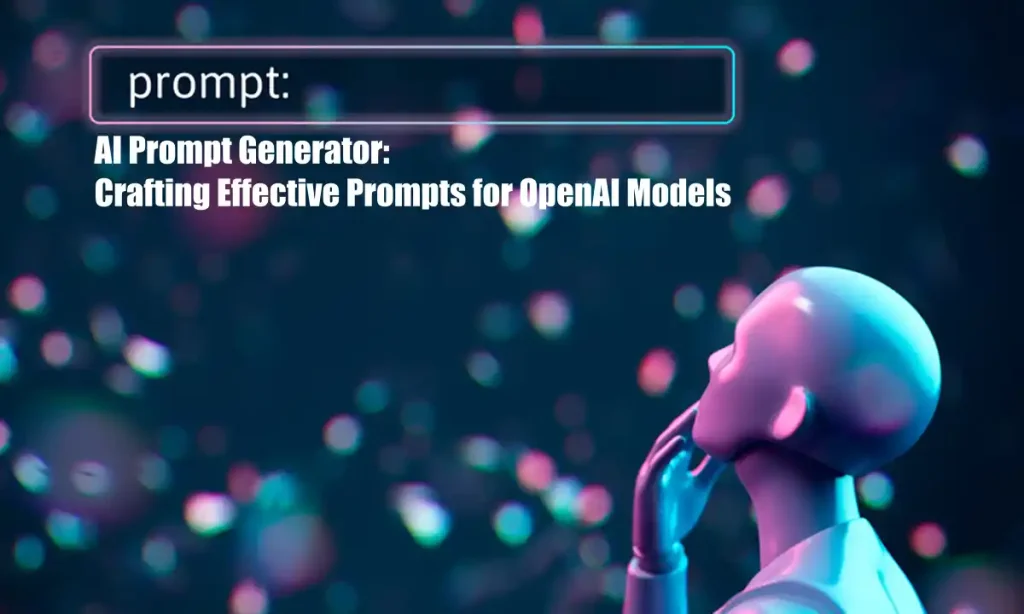
In the field of AI development, creating efficient prompts is essential for directing AI models such as OpenAI’s ChatGPT in producing the required results. They act as a means of interaction between users and AI-driven systems, aiding the AI in comprehending the situation and producing appropriate information. In this article, we’ll delve into What Is AI Prompt, How It Helps, and How To Create Prompt.
Definition Of Generative AI
Generative AI involves an AI model processing a prompt by drawing on patterns it has learned from its training data. This process includes calculating probabilities of word sequences and correlations based on both the prompt and training data to generate a contextually relevant response.
Specificity is key for prompts to generate the desired output successfully. Precise information like the type of essay, subject, mood, intended audience, and number of words will yield the preferred result instead of unclear and confusing prompts. Specific prompts in AI also help prevent inaccurate responses.
What Is AI Prompt?
A human can interact with a large language model through an artificial intelligence (AI) prompt, allowing the model to generate the desired output. This communication can come in the form of inquiries, written content, coding excerpts, or illustrations.
The AI model can generate different outputs depending on how the prompt is structured, ranging from a single word to a detailed paragraph. The goal of the prompt is to provide the AI model with enough information to generate relevant output.
Essentially, an AI prompt serves as a placeholder for inputting data into generative AI applications like chatbots.
You May Like: Master the Future of Search with Bing AI Chatbot: How to Use Bing with ChatGPT
Advantages of AI Prompts
AI prompts are utilized in various ways, such as generating text, translating languages, creating different types of creative content, and giving informative answers to queries. Regardless of how they are used, it is crucial to have well-designed AI prompts to ensure accurate and relevant information produced by AI models.
Some of the common advantages of using AI prompts include:
- Increased efficiency: Through clear AI prompts, users can obtain answers to their questions quickly and in a coherent manner, leading to a faster process of obtaining information compared to starting from scratch. Furthermore, effective prompts enable efficient retrieval of data from large databases.
- Enhanced customer service: Utilizing AI prompts enables customer service agents to swiftly and accurately address consumer inquiries. AI chatbots can be designed to handle common questions, provide basic assistance, and expedite order processing. This enhances efficiency, simplifies customer interactions, and boosts satisfaction levels.
- Personalization: AI prompts are customizable and can be tailored to individual preferences in terms of tone, style, and subject matter. This allows for the creation of unique content that meets specific needs.
- Educational tool: Teachers can use prompts to personalize learning experiences for each student, adapting instructional content to their needs and preferences. Prompt-based automatic evaluations and quick feedback can also aid in real-time learning.
- Time efficiency: AI prompts help to enhance and streamline communication between human language and AI models by minimizing repetitive explanations and swiftly retrieving information from extensive data sets. This results in saving hours of manual data research and boosting productivity.
- Response precision: A well-designed AI prompt effectively conveys a user’s intention to the AI model, leading to accurate and valuable responses.
- Improved decision-making: By receiving timely and accurate information through effective AI prompts, users can enhance their decision-making abilities, resulting in increased individual productivity and optimized organizational decision-making processes.
Read also: The Power Of AI And Machine Learning In Virtual Sport
Drawbacks of AI Prompts
The use of AI prompts can raise numerous challenges and ethical issues. It is crucial to continuously monitor the outputs of AI prompts to identify and address any potential biases, as well as to improve the quality of the prompts themselves. AI prompts may pose obstacles such as the ones listed below:
- Harmful content: AI systems can generate content based on AI prompts, which may inadvertently or purposely disseminate false or harmful information.
- AI hallucinations: This occurs when an AI model produces inaccurate information that is presented as if it were true. AI tools like OpenAI’s ChatGPT are programmed to predict word sequences based on user input, but they may struggle to apply logic or identify factual errors in their responses.
- Uncertainty: When there is a lack of clear context and input data, AI responses may be incorrect or irrelevant due to ambiguous instructions. The quality and type of input data, whether it be text or images, play a significant role in the AI model’s ability to generate specific results.
- Prejudiced outcomes: Failure to address societal biases and inequalities can result in biased outputs from AI prompts.
- Difficulty: Guiding the AI instructions can be challenging, especially for users with limited technical expertise on the subject matter.

How AI Prompts Work?
It is crucial to consider the target audience, context, and intended response when creating prompts for AI models. Writing prompts require an understanding of how elements like language models, machine learning, and natural language processing impact the generation process.
AI instructions offer explicit guidance to an AI or machine learning model, enabling it to generate a response. In this process, the model uses natural language processing and deep learning algorithms to examine and comprehend the user’s question or input.
Tips to Generate AI Prompts
Whether utilizing text-to-text or text-to-image AI tools like ChatGPT or Google Bard, mastering the skill of formulating precise questions is crucial for attaining the desired results.
Listed below are some suggestions on how to create successful AI prompts:
- Before prompts engineering, users should clearly define the objective and the desired output. For instance, the user may want the AI prompt to generate a blog post under 1,000 words or an AI image depicting a cat with green eyes and thick fur.
- Provide detailed instructions focused on specific traits like features, colors, textures, or aesthetic styles. Include contextual information and keywords for optimal results. Keep prompts concise with a three to seven word count for best AI response.
- It is essential to avoid using conflicting terms to prevent confusion in the AI model. For instance, combining “abstract” and “realistic” in a prompt may lead to unwanted results.
- Pose open-ended queries to stimulate a broader range of responses from the AI model. Instead of asking a simple “yes” or “no” question like “Is coffee harmful to health?” try inquiring about the pros and cons of coffee consumption on health.
- Utilize various AI tools and platforms to create effective prompts and produce high-quality AI-generated content. Websites such as ChatGPT, DALL-E, and Midjourney offer users the ability to customize prompts and generate content.

